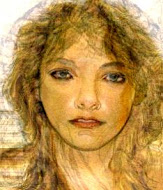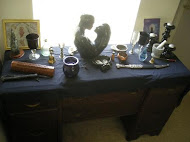This is taken in it's entirety from The Element Encyclopedia of Witchcraft by Judika Illes. I would like to take a moment here to again let you know how wonderful these books are. They are filled with history and knowledge, and I strongly recommend you run out and buy and copy. Then READ it. In our society pagans in general and witches particularly are perceived as "out there," "flaky," and generally uneducated. Knowing at least the history of your faith, and being able to discuss and defend it articulately are powerful tools that if put to everyday use can help dispel this image. If you are a pagan, a heathen, a witch, you have an obligation to your brothers & sisters in faith as well as to yourself, to present yourself in the best possible light. We all do. The information available in this book, and the others in the series - The Element Encyclopedia of Secret Societies and Hidden History, by John Michael Greer, The Element Encyclopedia of Magical Creatures, by John & Caitlin Matthews , The Element Encyclopedia of the Psychic World by Theresa Francis-Cheung, The Element Encyclopedia of Secret Signs & Symbols by Adele Nozedar to name a few, can help you.
Animism
In the late nineteenth and early twentieth centuries, Charles Darwin's then-revolutionary theory of evolution was also applied to the social sciences: so-called social Darwinism. Although this has fallen from fashion, at one time common anthropological wisdom was firmly convinced that human civilizations preceded orderly through Darwinian stages, with magical thought as the first, earliest stage. Some cultures advanced while others stopped, arrested at that early stage. Magical perspective, the witches' viewpoint, equaled primitive thought, with "primitive" implying something very negative, the antitheses of "civilization."
Because contemporary magical thinkers were also perceived as primitive, backwards, and foolish, even when Western and well-educated, there was no thought of consulting with them when excavating sites or examining magical images. (This is changing; archeologists at Catal Huyuk now engage in discussion with modern goddess devotees.) Instead attempts were made to define magical thinking from an outsider's point of view, an outsider who was proud of his distance from that perspective.
The word "animism" was coined by the English anthropologist Sir Edward Tylor (2 October 1832 - 2 January 1917), generally acknowledged as the "father of anthropology." Tylor gave this name to what was perceived as the earliest phase of magical and religious thinking, deriving it from the Greek "anima" meaning "soul." According to Tylor, prehistoric humans believed that every person, creature, and object - everything! - had a soul, was animated, and hence the name animism. That Sir Tylor did not identify or particularly empathize with the human subjects of his research is apparent by the words he chose to describe them: "savages" and "rude races." (No need to pick on Tylor, this was fairly standard language for anthropologists and social scientists of his time and later.)
Animism was perceived as a backwards, primitive, uncivilized, unenlightened belief: the lowest rung on the ladder to civilization. That said, if one can cut through the thicket of value judgements, Tylor came very close to defining what might be understood as magical perception: the vision of the world that makes shamanism, witchcraft, and magical practices possible and desirable.
It is an ecstatic vision. In this vision, everything is alive, continually interacts and can potentially communicate, if it so chooses, if it can be so compelled and, most crucially, if you can understand. There is no such thing as an inanimate object. Because you cannot hear or understand them doesn't mean rocks, wind, trees, and objects are not communicating or cannot communicate. The shaman can hear, the shaman can understand and, maybe most importantly, the shaman can hold up her end in a dialogue.
The shaman, sorcerer or witch (and whether at this stage of the game there is any difference is subject largely to linguistics) is the person who desires this knowledge and/or shows personal aptitude for this type of communication. This aptitude is invaluable and may have been crucial to the survival, success, and proliferation of the human species, Creation stories tend to end with that magical act of creation. What happened next? Quite often, as in that Zuni tale, the witches show up bearing life-saving knowledge and skill.
Imagine the earliest person on Earth, our most remote ancestors, encountering new plants, strange animals, and substances never before seen. They have no pre-existing scientific context.
Science posits a lengthy trial and error period. Conventional shamanic wisdom suggests that those animated plants, animals, and substances identified themselves and explained their gifts and dangers in a manner comprehensible to the shaman, who served as their medium to the greater human community. Animals, humans' elder siblings, taught us healing, hunting, and basic living skills. This is not ancient history. This type of shamanism still exists, although it is as endangered as the rainforests in which it is now largely centered.
Disclaimer: No one involved in this blog or its contents may be held responsible for any adverse reactions arising from following any of the instructions/recipes on this blog. It is the reader's personal responsibility to exercise all precautions and use his or her own discretion if following any instructions or advice from this blog.















No comments:
Post a Comment